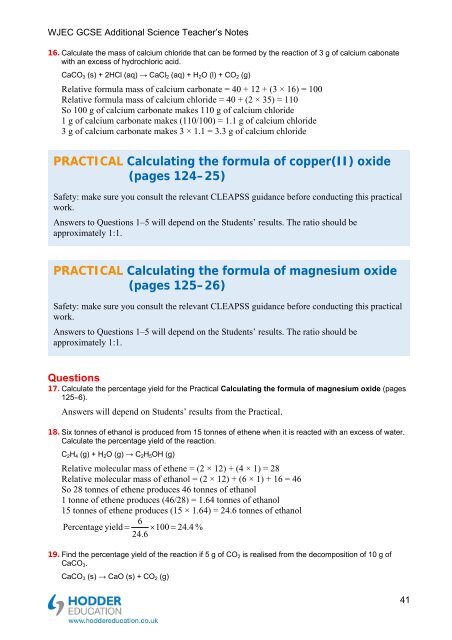Teacher's notes and answers to questions in the book - Hodder Plus ...
Teacher's notes and answers to questions in the book - Hodder Plus ...
Teacher's notes and answers to questions in the book - Hodder Plus ...
You also want an ePaper? Increase the reach of your titles
YUMPU automatically turns print PDFs into web optimized ePapers that Google loves.
WJEC GCSE Additional Science Teacher’s Notes<br />
16. Calculate <strong>the</strong> mass of calcium chloride that can be formed by <strong>the</strong> reaction of 3 g of calcium cabonate<br />
with an excess of hydrochloric acid.<br />
CaCO 3 (s) + 2HCl (aq) → CaCl 2 (aq) + H 2 O (l) + CO 2 (g)<br />
Relative formula mass of calcium carbonate = 40 + 12 + (3 × 16) = 100<br />
Relative formula mass of calcium chloride = 40 + (2 × 35) = 110<br />
So 100 g of calcium carbonate makes 110 g of calcium chloride<br />
1 g of calcium carbonate makes (110/100) = 1.1 g of calcium chloride<br />
3 g of calcium carbonate makes 3 × 1.1 = 3.3 g of calcium chloride<br />
PRACTICAL Calculat<strong>in</strong>g <strong>the</strong> formula of copper(II) oxide<br />
(pages 124–25)<br />
Safety: make sure you consult <strong>the</strong> relevant CLEAPSS guidance before conduct<strong>in</strong>g this practical<br />
work.<br />
Answers <strong>to</strong> Questions 1–5 will depend on <strong>the</strong> Students’ results. The ratio should be<br />
approximately 1:1.<br />
PRACTICAL Calculat<strong>in</strong>g <strong>the</strong> formula of magnesium oxide<br />
(pages 125–26)<br />
Safety: make sure you consult <strong>the</strong> relevant CLEAPSS guidance before conduct<strong>in</strong>g this practical<br />
work.<br />
Answers <strong>to</strong> Questions 1–5 will depend on <strong>the</strong> Students’ results. The ratio should be<br />
approximately 1:1.<br />
Questions<br />
17. Calculate <strong>the</strong> percentage yield for <strong>the</strong> Practical Calculat<strong>in</strong>g <strong>the</strong> formula of magnesium oxide (pages<br />
125–6).<br />
Answers will depend on Students’ results from <strong>the</strong> Practical.<br />
18. Six <strong>to</strong>nnes of ethanol is produced from 15 <strong>to</strong>nnes of e<strong>the</strong>ne when it is reacted with an excess of water.<br />
Calculate <strong>the</strong> percentage yield of <strong>the</strong> reaction.<br />
C 2 H 4 (g) + H 2 O (g) → C 2 H 5 OH (g)<br />
Relative molecular mass of e<strong>the</strong>ne = (2 × 12) + (4 × 1) = 28<br />
Relative molecular mass of ethanol = (2 × 12) + (6 × 1) + 16 = 46<br />
So 28 <strong>to</strong>nnes of e<strong>the</strong>ne produces 46 <strong>to</strong>nnes of ethanol<br />
1 <strong>to</strong>nne of e<strong>the</strong>ne produces (46/28) = 1.64 <strong>to</strong>nnes of ethanol<br />
15 <strong>to</strong>nnes of e<strong>the</strong>ne produces (15 × 1.64) = 24.6 <strong>to</strong>nnes of ethanol<br />
Percentage yield<br />
6<br />
100<br />
24.4 %<br />
24.6<br />
19. F<strong>in</strong>d <strong>the</strong> percentage yield of <strong>the</strong> reaction if 5 g of CO 2 is realised from <strong>the</strong> decomposition of 10 g of<br />
CaCO 3 .<br />
CaCO 3 (s) → CaO (s) + CO 2 (g)<br />
41

















